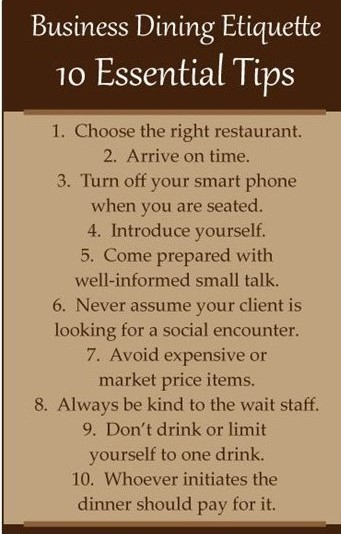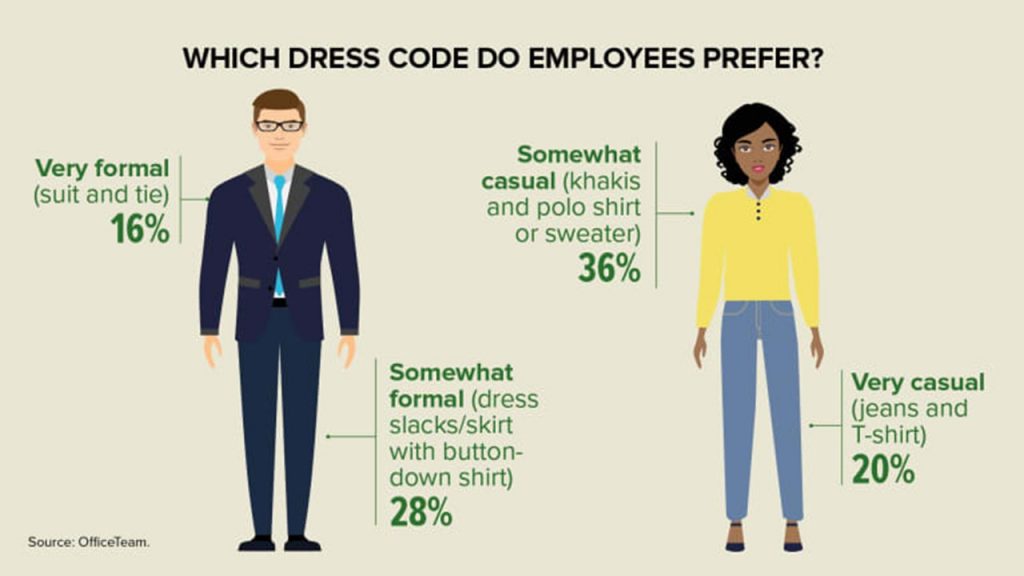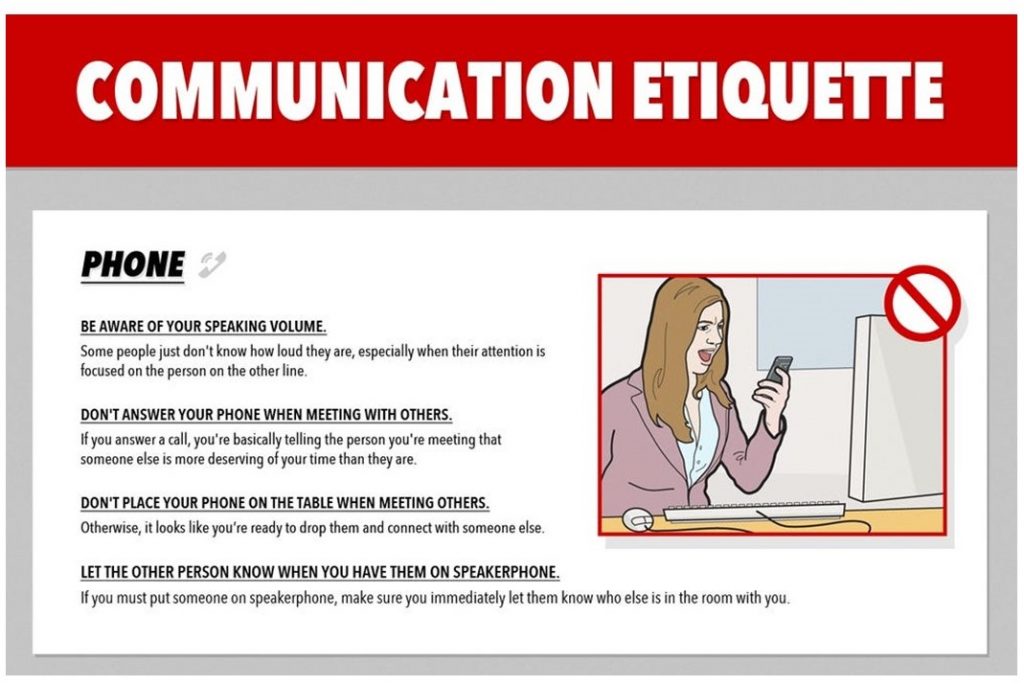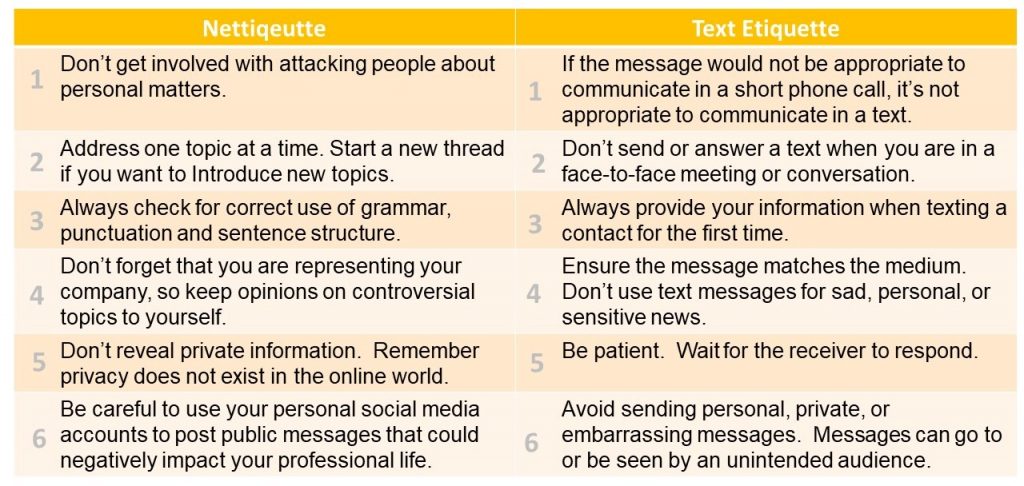8.2 Business Etiquette
Learning Objectives
 After reviewing this information, you will be able to
After reviewing this information, you will be able to
-
-
- identify the importance of business etiquette
-
Introduction
Good manners and a professional attitude is an important intangible skill in the work environment. Employers want to hire and your peers will want to work with friendly, pleasant, and polite people. These intangible skills are called Business Etiquette. Your personal behaviour is important in establishing and maintaining harmony and contributing to a positive and energetic work environment. Our earlier examination of specific writing skills (e.g., using courteous, polite, and passive language) touched on this concept in written language. Here, we will examine specific applications of etiquette associated with how you present yourself in social situations, what type of telephone manners you have, your professional appearance and other areas of business etiquette.
Business Etiquette in Social Settings1
From business lunches to conferences, you may need to represent your company in a variety of social settings. If you are at such an event, remember your manners will be assessed. Though it may not be obvious, people will observe whether you use your utensils correctly, chew with your mouth closed, use your cell phone when others are speaking, or dress appropriately. Why does all this matter?
You may think all of this has nothing to do with the quality of work; however, your business etiquette shows the extent to which you developed appropriate habits and are self-aware. Someone who chews with his/her mouth open, for instance, either lacks self-awareness or does not care what people think. Either way, that lack of self-awareness can lead to behaviors that will ruin the reputation of the company you represent.

Here are some tips on proper etiquette in social situations.
- Get to know the culture of your audience. For example, in Canada a firm handshake is expected, while in Japan a bow of the head is expected
- Include a brief description of your role in the company when introducing yourself to others
- Know basic dining etiquette: don’t order alcohol, order food that is easy to eat, leave business documents under your chair or in your briefcase until the entree plates have been removed
- Don’t use your cell phone until the meeting has concluded
- Stay away from controversial topics, like politics, religion and personal matters
- Don’t speak poorly of your employer or job
- Avoid profanity and be careful with humour
Dressing Appropriately for the Workplace
When we hear the word uniform, we often think of a very specific style such as what a police officer or nurse wears. In a general sense, however, we all wear uniforms of various styles in whatever professional or institutional environment we participate in. Dressing appropriately in those situations and in the workplace specifically has everything to do with meeting expectations. In an office environment, clients, coworkers, and managers expect to see employees in either suits or a business-casual style of dress depending on the workplace. In such situations, conformity is the order of the day, and breaking the dress code can be a serious infraction.
Though some infractions are becoming less serious in many places because the general culture is becoming more accepting of tattoos, piercings, and dyed hair as more and more people use these to express themselves, you might need to be careful. Consider the following points:
- Tattoos: Though a significant proportion of the population has tattoos and therefore they are more acceptable across the board, overly conspicuous tattoos are still considered taboo. Tattoos on the face, neck, or hands, for instance, are considered risky because of their association with prison and gang branding. Tattoos that can be covered by a long-sleeved shirt with a collar and slacks are a safe bet. However, if you have tattoos on your forearms depicting scenes of explicit sex or violence, consider either getting them removed or never rolling up your sleeves if you want to get hired and keep your job.
- Piercings: Of course, earrings are de rigueur for women and acceptable on men as well. However, earlobe stretching and piercings on the nasal septum or lips are still generally frowned upon in professional settings. Any serious body modification along these lines is acceptable in certain subcultures, but not in most workplaces.
- Dyed hair: As with tattoos and piercings, hair dye is becoming more acceptable generally, but extreme expression is inadvisable in any traditional workplace. Where customer expectations are rigid (e.g., in a medical office), seeing someone with bright pink hair will give the impression of an amateur operation rather than a legitimate health care facility.
Because conformity is the determining factor of acceptability in proper attire in any particular workplace, the best guide for how to dress when you are not given a specific uniform is what everyone else wears. Observe closely the style of your co-workers and build a similar wardrobe. If the fashion is slacks with a belt that matches the color of your shoes and a long-sleeve, button-up, collared shirt for men and a full-length skirt and blouse for women, do the same. You might be against conformity, but consider this: according to a recent report a majority of managers report that an employee’s attire affects his/her chances of receiving a promotion.2

Telephone Etiquette
The telephone is an essential communication medium that you will use frequently throughout your career. Business conversations over the phone are often direct and time-sensitive. Just like a letter, memo, or email, you don’t want to make a phone call unless there is a reason. Thus, knowing some general rules around making business calls will ensure you are always prepared for all your telephone conversations.
- Give each phone call your full attention. Try not to have side conversations or answer other calls during your conversation.
- Plan what you will say. People are busy so use your time and their time efficiently.
- Leave clear messages. If someone is not available, leave a message with your contact information and the reason for the call.
- Have telephone manners. Don’t do things like chewing gum while speaking with someone.
- Use a professional tone. Remember, the receiver can not see your body language. Therefore, non-verbal cues, such as tone of voice, become even more important in effectively communicating a message.
- Excuse yourself when you step away from the phone. If you need to leave your desk, inform the receiver.
- Apply active listening skills. Pay close attention to what the receiver is saying.

Business Etiquette in the Digital Age
People sometimes forget that good digital communication etiquette is as important as non-digital communication etiquette and can have as many potential pitfalls. Just as you represent your organization in face-to-face interactions, you do the same through your digital interaction with your company’s stakeholders. Thus, learning the basics of professional etiquette in the digital world will be beneficial to your career. Figure 45.4 provides some professional etiquette tips for communicating online and via text message.

Virtual Meetings
Many things about how business is conducted have changed. One of the areas most impacted is the rise and prevalence of virtual meeting. Virtual meetings are here to stay. Learning how to organize and participate in them will prove beneficial. The video below presents some virtual meeting etiquette best practices you should know.
Exercises
 1. First, think of someone who exemplifies everything you aspire to be in terms of their good behaviour in the workplace (loosely defined as anywhere someone does work—not necessarily where it’s compensated with money). List the qualities and actions that make them such a good, well-liked model for behaviour. Second, think of someone who exemplifies everything you aspire to avoid in terms of their misconduct in the workplace. List the qualities and typical misbehaviour that make them so detestable.
1. First, think of someone who exemplifies everything you aspire to be in terms of their good behaviour in the workplace (loosely defined as anywhere someone does work—not necessarily where it’s compensated with money). List the qualities and actions that make them such a good, well-liked model for behaviour. Second, think of someone who exemplifies everything you aspire to avoid in terms of their misconduct in the workplace. List the qualities and typical misbehaviour that make them so detestable.
References
2Agovino, T. (2018). Fashion statement. SHRM. Retrieved from https://www.shrm.org/hr-today/news/all-things-work/pages/fashion-statement.aspx
1Adapted from Bovee, C., Thill, J., & Scribner, J. (2016). Business communication essentials (4th ed.). Toronto, ON: Pearson Canada Inc. Retrieved from http://www.pearsoncanada.ca/highered/product-showcase/new-solutions-for-core-foundations-from-pearson-canada/business-communication-essentials-fourth-canadian-edition-4e
Bovee and Thill Business Communication Video. (2018). The five zones of professional ethics [Video]. Youtube. https://www.youtube.com/watch?v=A9Q20hZ5ZX4
Etiquettescholar. (2019) Dining meal etiquette. Retrieved from https://www.etiquettescholar.com/dining_etiquette/business_etiquette.html
Forbes. (2020). Conference call etiquette for those who work from home [Video]. Youtube. https://www.youtube.com/watch?v=F-9Xk-qY4uQ
Guffey, M., Loewry, D., & Griffin, E. (2019). Business communication: Process and product (6th ed.). Toronto, ON: Nelson Education. Retrieved from http://www.cengage.com/cgi-wadsworth/course_products_wp.pl?fid=M20b&product_isbn_issn=9780176531393&template=NELSON
Lee, S. (2015). 8 phone etiquette rules every professional should know. Businessinsider.com. Retrieved from https://www.businessinsider.com/8-phone-etiquette-rules-every-professional-should-know-2015-5

